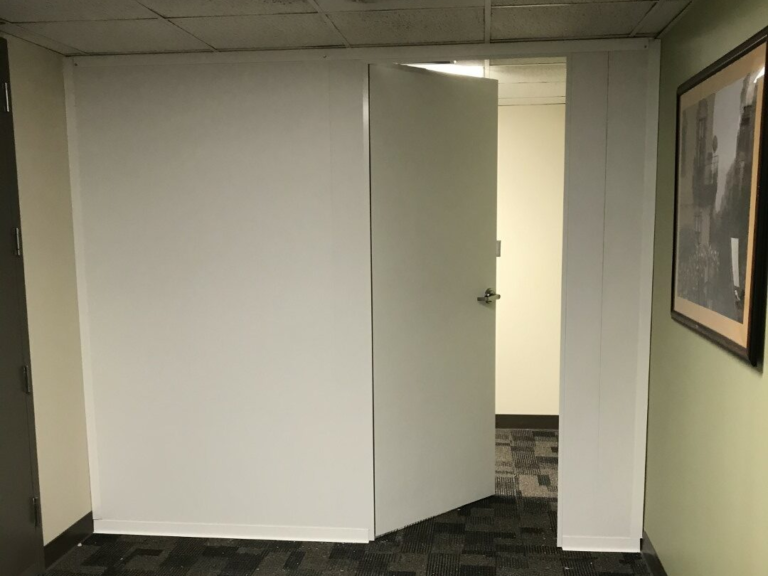An ICRA plan plays a central role in healthcare construction and renovation, safeguarding patient safety and providing necessary building activities.
But does ICRA stand for, and what are some of the best practices for ICRA construction?
Here’s everything you need to know to create an effective ICRA plan—and use Swiftwall® while doing it.
What Does ICRA Stand For?
ICRA stands for Infection Control Risk Assessment, a process aimed at identifying and mitigating risks associated with construction activities in healthcare construction settings.
The goal is to protect vulnerable patient populations from the potential spread of contaminants during building and renovation projects.
However, given the complex nature of healthcare environments, where even minor disruptions can have significant consequences, an ICRA plan is used as an integral part of maintaining patient care.
ICRA Protocols and Risk Classifications
ICRA protocols are designed to assess and mitigate the risks associated with various construction activities by classifying them based on their potential to generate airborne contaminants.
These classifications, ranging from Type A (minimal risk) to Type D (high risk), guide the determination of appropriate infection control measures.
Impact on Adjacent Spaces
ICRA is not only concerned with the immediate area of construction but also with adjacent spaces that could be impacted.
This includes areas above, below, and around the construction site where dust and pathogens could migrate through ventilation systems or physical connections like stairways and elevators.
The assessment also considers the patient risk groups present in these areas, from low-risk environments like administrative offices to the highest-risk zones like ICUs.
CDC Mandates and Compliance
The CDC mandates that healthcare facilities implement ICRA protocols that ensure construction barriers are impermeable to dust and pathogens—especially in spaces that require high levels of sterility.
Why is that?
Because the implementation of these protocols:
- Maintains the safety of patients, staff, and visitors throughout the construction process
- Prevents healthcare-associated infections (HAIs)
- Ensures compliance with local and national health regulations
Components of an ICRA Plan During ICRA construction

When developing an ICRA plan, these are the components you need to make sure every plan has:
Identified Construction Activities and Risk Levels
The first step in developing an ICRA plan is identifying the type of construction activity, categorized into Types A through D based on the level of disruption they cause.
- Type A activities involve minor maintenance with minimal dust production.
- Type D includes major construction work that generates significant debris.
Each activity type is matched with a corresponding risk level—ranging from low to highest—based on proximity to patient care areas.
Identified Patient Risk Groups
This includes identifying patient risk groups, which vary depending on the hospital area. High-risk patients, such as those in ICUs or undergoing chemotherapy, require the most protection. And the construction plan should establish necessary protocols and procedures to avoid exposing these patients to contaminants.
Defined Precaution Classes
The plan must also define the class of precautions, which range from Class I (minimal precautions) to Class IV (maximum precautions).
Although these depend on the nature of the construction activity and the surrounding area, typical larger construction elements are set under the maximum precautions whereas smaller projects are set within limited precautions.
Accurate Area Assessments
Assessing the surrounding areas is also important. In other words, areas need to be assessed to determine if they will be adversely affected by the construction—or have the ability to cause any form of construction disruption.
This component typically involves implementing additional controls, such as negative air pressure systems or temporary barriers, to prevent the spread of contaminants.
ICRA Negative Pressure Requirements and Their Importance
Speaking of which, negative pressure systems are a significant component to any ICRA plan. Here’s why:
Negative Pressure Protects Patients From Construction
By establishing and maintaining negative air pressure within construction zones, air is kept from flowing outward into adjacent areas.
This containment protects sensitive hospital environments, such as operating rooms, intensive care units (ICUs), and oncology wards from harmful particles like dust, mold spores, and other contaminants generated during construction.
Continuous Monitoring and Compliance
Maintaining negative pressure requires continuous monitoring throughout the construction process. This is achieved through several key methods. To name a few:
- Manometers or digital pressure monitoring systems: Provide real-time data on pressure differentials.
- Immediate corrective actions: Become necessary when pressure falls outside the required range to restore proper conditions.
- Comprehensive oversight: Ensure all aspects of the construction project adhere to ICRA construction standards.
SwiftWall® Modular Wall Systems for ICRA Construction Compliance
SwiftWall® modular wall systems are meticulously engineered to meet the stringent requirements of ICRA-compliant construction. Here are the most popular products from Swiftwall® for this purpose:
Swiftwall Pro
The SwiftWall® Pro system is a versatile solution for temporary walls, which is designed specifically to maintain compliance with infection control and ICRA construction standards in healthcare environments.
Although it’s a lightweight temporary wall, it’s a durable construction barrier that can be quickly installed and reconfigured.
SwiftWall® Max
The SwiftWall® Max system is the best modular wall solutions that’s tailored for healthcare construction projects. It’s engineered to enhance structural integrity and provide a perfect combination of durability and flexibility.
The system features advanced sound attenuation and superior dust containment capabilities that ensure a safe and quiet environment for patient care.
Maximize ICRA Construction Compliance with SwiftWall®

SwiftWall’s modular wall systems provide the ultimate solution for maintaining infection control during healthcare construction and renovation projects.
Designed to meet the highest standards, these products ensure safety and efficiency across all levels of ICRA compliance.
Contact us today to discover how our innovative systems can support your next healthcare construction project.


